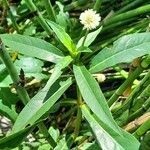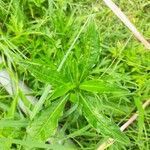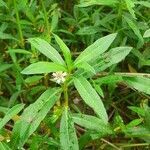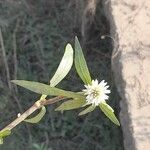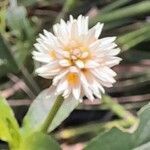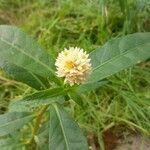Perennial aquatic herb to 1 m; stems hollow, striate, rooting at lower nodes, pressing to ca. 1.3 cm wide. Petiole 1-16 mm long; blade lanceolate, oblanceolate, oblong-lanceolate or narrowly ovate, 2-10 x 0.5-2.7 cm, entire or sometimes subdenticulate, apex obtuse to acute, base cuneate and tapering to petiole, subcarnose, glabrous above, glabrous or subglabrous beneath. Inflorescence usually axillary (sometimes and/or terminal), 1.0-5.5 cm long pedunculate, solitary heads; heads hemispherical or subglobose, 10-18 x 10-18 mm; bracts and bracteoles subequal, ovate, 1-2 mm long, acuminate, bracteoles much shorter than tepals, glabrous, central vein not prominently raised. Tepals white, oblong-lanceolate, 5-6 x 1.5-2.5 mm, acuminate, mucronulate, denticulate at apex, glabrous, faintly veined; stamens 5, pseudostaminodia exceeding stamens, lacerate; style about twice as long as stigma, stigma capitate. Utricle reniform, 1.0 x 1.0-1.5 mm.
Decumbent or ascending glabrate aquatic perennials, the simple or branched, often fistulose stems to 100 cm. long. Leaves glabrous or glabrate, lanceolate to narrowly obovate, apically rounded to acute, basally cuneate, rarely denticulate, 2-10 cm. long, 0.5-2 cm. broad; petioles 1-3 mm. long. Inflorescences of terminal and occasionally axillary white glomes, 10-18 mm. long, 10-18 mm. broad, the usually unbranched peduncles 1-5 cm. long. Flowers perfect, bracts and bracteoles subequal, ovate, acuminate, 1-2 mm. long; sepals 5, subequal, oblong, apically acute and occasionally denticulate, neither indurate nor ribbed, 5-6 mm. long, 1.5-2.5 mm. broad; stamens 5, united below into a tube, the pseudostaminodia lacerate and exceeding the anthers; ovary reniform, the style about twice as long as the globose capitate stigma. Fruit an indehiscent reniform utricle 1 mm. long, 1-1.5 mm. broad; mature seeds not seen.
Perennial herb; stems creeping or floating, ascending towards apex, rooting at the lower nodes, branched, hollow, with a longitudinal hairy groove on 2 opposite sides. Lvs subsessile or with petiole to 5 mm long, with a ring of white hairs between the 2 opposite lf bases. Lamina 3-13 × 1-3.5 cm, elliptic to oblanceolate or obovate, glabrous or slightly hairy near the attenuate base; apex obtuse or acute. Infls in upper axils, mostly 1-2 cm diam., capitate, white; peduncles to 9 cm long with 2 opposite longitudinal hairy grooves, occasionally heads shortly pedunculate and terminal. Bracts 2.5-3.5 mm long, ovate-acuminate; bracteoles similar to bracts, somewhat smaller, persistent. Tepals 5-7 mm long, oblong to ovate, acute or obtuse. Fertile stamens 5; staminodes = stamens. Style short, thick; stigma capitate. Fr. not seen.
Herbs perennial. Stem ascending from a creeping base, 55-120 cm, branched; young stem and leaf axil white hairy; old ones glabrous. Petiole 3-10 mm, glabrous or slightly hairy; leaf blade oblong, oblong-obovate, or ovate-lanceolate, 2.5-5 × 0.7-2 cm, glabrous or ciliate, adaxially muricate, base attenuate, margin entire, apex acute or obtuse, with a mucro. Heads with a peduncle, solitary at leaf axil, globose, 0.8-1.5 cm in diam. Bracts and bracteoles white, 1-veined, apex acuminate; bracts ovate, 2-2.5 mm; bracteoles lanceolate, ca. 2 mm. Tepals white, shiny, oblong, 5-6 mm, glabrous, apex acute. Filaments 2.5-3 mm, connate into a cup at base; pseudostaminodes oblong-linear, ca. as long as stamens. Ovary obovoid, compressed, with short stalk. Fruit not known. Fl. May-Oct. 2n = 100*.
Stout perennial herb 3–10 dm, ascending or decumbent, villous at least in the axils; lvs subsessile, linear-elliptic to elliptic or obovate, 3.5–11 × 0.5–2 cm; peduncles axillary or terminal, simple, 1–5 cm, pilose; heads globose, 1.5 cm thick, white; bracts a fourth as long as the sep, broadly ovate, acute or acuminate, glabrous; sep ovate-oblong, 6 mm, acute or acutish, subchartaceous; staminodes surpassing the anthers; style elongate, the stigma entire. Wet places; native to tropical Amer., intr. as a weed in the coastal states from se. Va. to Fla. and Tex.
Herbs, perennial, aquatic to semiterrestrial, stoloniferous, to 50 dm. Stems prostrate, forming mats, often fistulose, glabrous. Leaves sessile; blade narrowly elliptic, elliptic, or oblanceolate, 3.5-7.1 × 0.5-2 cm, herbaceous, apex acute to obtuse, glabrous. Inflorescences terminal and axillary, pedunculate; heads white, globose, 1.4-1.7 cm diam.; bracts not keeled, less than 1/2 as long as tepals. Flowers: tepals monomorphic, white, lanceolate or oblong, 6 mm, apex acute, glabrous; stamens 5; pseudostaminodes ligulate. Utricles not seen. Seeds not seen.
A marsh herb. It has runners or stolons. These can be 10 m long. It roots at the nodes. The stems are hollow and triangular. It can form floating masses on water. The leaves are opposite and narrow. They do not have stalks. They are 2-7 cm long by 1-2 cm wide. The flowers are white in heads on long stalks. The heads are 1 cm across and made up of several flowers. They are in the axils of leaves.
